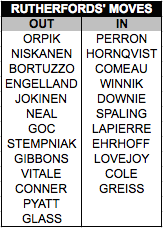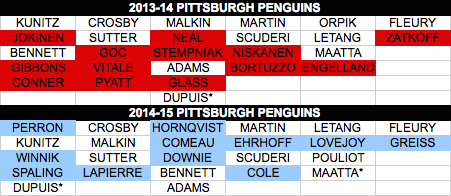Make no mistake about it: these Penguins are Jim Rutherford’s team. The Penguins general manager continued to put his mark on his team, making a pair of deals before Monday’s trade deadline, acquiring defensemen Ben Lovejoy and Ian Cole.
As the Penguins roster in currently constituted, Rutherford has either signed or traded for 11 of the 24 players on the team, more than predecessors Ray Shero (9) and Craig Patrick (4).
In addition to the lineup, the Rutherford has replaced the entire coaching staff and rearranged the front office. So when the Penguins enter the Stanley Cup playoffs next month, it will be with a team of Rutherford’s players, playing the under his coaches, with his system.
 It’s an important point to consider, because with Rutherford only on a three-year contract, there won’t be many opportunities for Penguins management to evaluate their first-year GM.
It’s an important point to consider, because with Rutherford only on a three-year contract, there won’t be many opportunities for Penguins management to evaluate their first-year GM.
While his ability to make moves may have been hamstrung by the lack of salary cap space and some outright atrocious contracts on the books that were left behind by Shero, there can be no question that the lineup that the Penguins will ice going forward has been constructed by Rutherford.
Shero, despite his many flaws, was unquestionably a trade deadline all star. He made some of the biggest trades in team history and seemed to fleece opposing general managers regularly.
His success at the trade deadline, however, never seemed to push the team over the top in the post-season. The Penguins won the Stanley Cup in 2009 after one of his quieter trade deadlines, only acquiring Bill Guerin from the Islanders for a fifth-round pick.
Since Rutherford arrived, his focus has not been about winning trades, but getting the right players. He has targeted specific players for specific roles – Patric Hornqvist’s ability and willingness to go the front of the net, something so notably lacking in the Penguins’ game under Shero and Dan Bylsma – and then paid the price to get the right player.
It’s a bold strategy, one that requires trust in one’s scouting methods and the ability to continually identify the team’s weaknesses as time moves on. That’s what Rutherford will be judged on when the Penguins players – his players – hit the ice in the postseason.
